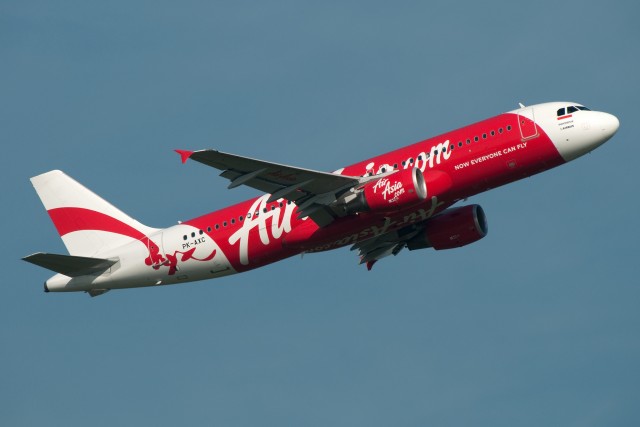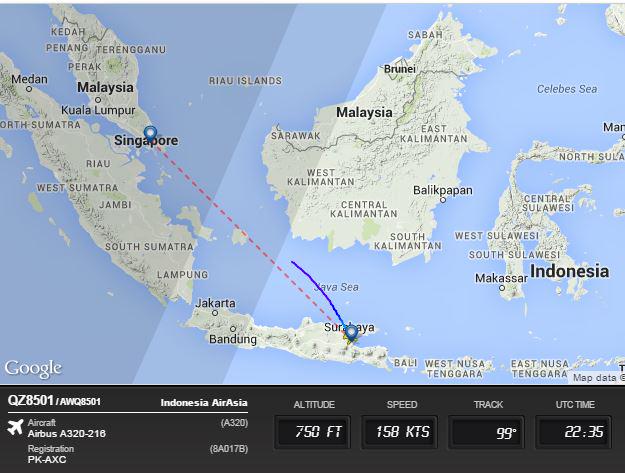
The AirAsia Airbus A320 in question (PK-AXC) seen here in 2010. On December 28, 2014, this plane would be used on AirAsia Flight QZ8501 that has now been confirmed crashed – Photo: Bruno Geiger | Flickr CC
On December 28th, at 6:12 am local time, Indonesia AirAsia flight QZ8501, traveling from Surabaya, Indonesia to Singapore, went missing over the Java Sea. On Tuesday the 30th, wreckage of the plane was discovered in the general area where the last known location was, confirming that QZ8501 had crashed.
The aircraft involved was an Airbus A320-216 registered PK-AXC. Contact was lost with the flight as it was climbing to a higher altitude to avoid weather, which is a standard operating procedure.
There were 155 passengers and seven crew. The cause of crash will likely not be known for quite some time still.
This story will be updated as new information is received. Last updated 12/30/2014 6:40am PST.

Route map of QZ8501 showing it disappearing somewhere over the Java Sea – via Jason Rabinowitz on FlightRadar24
AirAsia Flight QZ8501 Updates
12/30 7:20am PST: The worst has been confirmed, flight AirAsia flight QZ8501 crashed into the Java Sea and officials have found wreckage and the remains of passengers on board. They discovered the wreckage about 100nm southwest of Pangkalan Bun in Borneo. Rescuers will continue to search for bodies, wreckage, and of course the flight data recorder (aka black boxes). The black boxes and parts of the fuselage have technologies so rescuers can more easily discover them.
According to aviation journalist Jason Rabinowitz, the fuselage has Emergency Locator Transmitters (ELTs), which are used to find debris above water and Underwater Locator Beacons (ULBs), which are located with the boxes, are used when they are underwater. “Every commercial aircraft has multiple location technologies on board,” Rabinowitz explained to AirlineReporter. “ELTs are located in several spots on the aircraft. These transmitters emit a signal that can be received by other aircraft, boats, or even satellites. However, they do not work once submerged in water.”
“Attached to each black box is an ULB. These beacons are activated once in water and emit a ping over a very specific radio frequency. The ULB has a very short range, and must be picked up by boats passing over the area. The battery typically lasts for around 30 days.”
AirAsia has released another statement:
SURABAYA, 30TH DECEMBER 2014 ’“ AirAsia Indonesia regrets to inform that The National Search and Rescue Agency Republic of Indonesia (BASARNAS) today confirmed that the debris found earlier today is indeed from QZ8501, the flight that had lost contact with air traffic control on the morning of 28th.
The debris of the aircraft was found in the Karimata Strait around 110 nautical miles south west from Pangkalan Bun. The aircraft was an Airbus A320-200 with the registration number PK-AXC. There were 155 passengers on board, with 137 adults, 17 children and 1 infant. Also on board were 2 pilots, 4 cabin crews and one engineer.
At the present time, search and rescue operations are still in progress and further investigation of the debris found at the location is still underway. AirAsia Indonesia employees have been sent to the site and will be fully cooperating with BASARNAS, National Transportation Safety Committee (NTSC), and relevant authorities on the investigation.
Sunu Widyatmoko, Chief Executive Officer of AirAsia Indonesia said: ’œWe are sorry to be here today under these tragic circumstances. We would like to extend our sincere sympathies to the family and friends of those on board QZ8501. Our sympathies also go out to the families of our dear colleagues.’
Tony Fernandes, Group Chief Executive Officer of AirAsia added: ’œI am absolutely devastated. This is a very difficult moment for all of us at AirAsia as we await further developments of the search and rescue operations but our first priority now is the wellbeing of the family members of those onboard QZ8501.’